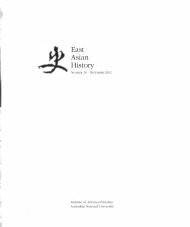Exhibiting Meiji Modernity: Japanese Art at the ... - East Asian History
Exhibiting Meiji Modernity: Japanese Art at the ... - East Asian History
Exhibiting Meiji Modernity: Japanese Art at the ... - East Asian History
- No tags were found...
You also want an ePaper? Increase the reach of your titles
YUMPU automatically turns print PDFs into web optimized ePapers that Google loves.
EXHIBITING MEIJI MODERNITY<br />
93<br />
oil; pamtmgs in w<strong>at</strong>er-colour), Plastic (sculptures in marble, sculptures<br />
in bronze) and Decor<strong>at</strong>ive (basically etchings, engravings, and paintings<br />
on various m<strong>at</strong>erials).80 A browse through <strong>the</strong> c<strong>at</strong>alogue confirms th<strong>at</strong><br />
<strong>the</strong> exhibitions from everywhere but Japan were encompassed by <strong>the</strong><br />
six major c<strong>at</strong>egories 81 The cloisonne triptych would without doubt have<br />
been quite <strong>at</strong> home among <strong>the</strong> orn<strong>at</strong>e, technically brilliant and expensive<br />
objects European n<strong>at</strong>ions displayed in <strong>the</strong> Hall of Manufactures. The Fine<br />
<strong>Art</strong>s galleries-apart from Japan's-contained nothing but floor-to-ceiling<br />
exhibits of framed paintings in oils and w<strong>at</strong>ercolours, and floor displays<br />
of sculptures on pedestals. The <strong>Japanese</strong> Commission petitioned for a<br />
relax<strong>at</strong>ion of <strong>the</strong> classific<strong>at</strong>ions to exhibit in <strong>the</strong> Palace of Fine <strong>Art</strong>s <strong>at</strong><br />
Chicago, and a compromise was evidently reached. Simply being allowed<br />
to exhibit in this department was, however, not enough. As Furuta comments,<br />
pictures were framed in a manner so as to place <strong>the</strong>m on a level<br />
footing with <strong>the</strong> European works with which <strong>the</strong>y were in competition. 82<br />
Fine art production was a measure of civiliz<strong>at</strong>ion, and to establish Japan's<br />
claim in this it needed to win in open, intern<strong>at</strong>ional competition, and<br />
was prepared to make compromises to do so. Never<strong>the</strong>less, as <strong>the</strong> contemporary<br />
comment<strong>at</strong>or William E. Cameron observed after several pages<br />
of rapturous descriptions of European offerings, <strong>the</strong> <strong>Japanese</strong> art exhibit<br />
was "different,,83<br />
The difference derived from <strong>the</strong> need to demonstr<strong>at</strong>e Japan's artistic<br />
accomplishments by taking prizes in fine art using techniques and<br />
media th<strong>at</strong> <strong>the</strong> West associ<strong>at</strong>ed with crafts, <strong>the</strong> manufacture of useful<br />
things. Cameron mentions in particular a piece of tapestry representing <strong>the</strong><br />
"G<strong>at</strong>e of Nikko during a festival ", which showed hundreds of figures and<br />
took four years to complete. 84 This was <strong>the</strong> most highly acclaimed of <strong>the</strong><br />
several large tapestries Japan exhibited, in which a technique traditionally<br />
reserved for obi, <strong>the</strong> long narrow kimono sash, was used for <strong>the</strong> first time<br />
in textiles large enough to rival <strong>the</strong> proportions of Gobelin-type tapestries<br />
of Europe. 85 O<strong>the</strong>r textile techniques associ<strong>at</strong>ed with making kimono were<br />
also pushed beyond <strong>the</strong>ir familiar form and function. The pictorial possibility<br />
of yUzen 1z:fij!. dyeing was presented in a six-panel screen of flowers<br />
and birds. 86 Excellence in embroidery was displayed in a four-fold screen<br />
depicting a peacock. The result was a new genre of <strong>Japanese</strong> art th<strong>at</strong><br />
quickly became established among western consumers as represent<strong>at</strong>ive<br />
of <strong>Japanese</strong> tradition, au<strong>the</strong>ntic<strong>at</strong>ed as <strong>Japanese</strong> and assumed to be "traditional"<br />
by its difference from anything produced in <strong>the</strong> West.<br />
Wh<strong>at</strong> <strong>the</strong>n did western audiences make of <strong>the</strong> Kyoto brocade, with a<br />
small all-over p<strong>at</strong>tern of traditional <strong>Japanese</strong> musical instruments, simply<br />
labelled "cloth for western garment,,87 While this might appear simply to<br />
be export ware, we should bear in mind th<strong>at</strong> by this time many <strong>Japanese</strong><br />
women of rank-such as <strong>the</strong> empress herself-wore western-style<br />
80 Fine Alts would seem to be <strong>the</strong> most<br />
self-explan<strong>at</strong>ory of depaltments <strong>at</strong> <strong>the</strong> fair<br />
since it occupies a fraction of <strong>the</strong> space in<br />
<strong>the</strong> c<strong>at</strong>alogue of most o<strong>the</strong>rs. In summa ry,<br />
"Sculpture" is plastic alt in marble or bronze;<br />
"Pictorial art" is painting in oil or w<strong>at</strong>ercolour.<br />
The rest falls into <strong>the</strong> less prestigious c<strong>at</strong>egory<br />
of "Decor<strong>at</strong>ive <strong>Art</strong>".<br />
81 Sweden offered one piece in group<br />
141 and one in 142: a sculpture of Columbus's<br />
arrival in America cut with a pen<br />
knife from a block of hardwood (p.188).<br />
France was <strong>the</strong> o<strong>the</strong>r large contributor to<br />
"Objects of Decor<strong>at</strong>ive <strong>Art</strong>" (22 pieces),<br />
72 exhibits of ceramics, and 37 in metal<br />
gold work. [ves, Official C<strong>at</strong>alogue, says<br />
Depaltment K. Japan contributed most of<br />
<strong>the</strong> works in Decor<strong>at</strong>ive Alt, but only 24<br />
of <strong>the</strong> 1,013 sculptures and 55 of <strong>the</strong> 7,357<br />
paintings.<br />
82 1893 ReViSited, p.94.<br />
83 Cameron, <strong>History</strong> of <strong>the</strong> World's Columbian<br />
Exposition, p.98.<br />
84 Ibid. This piece, which measures no less<br />
than 381 x 686cms, is now in <strong>the</strong> coLlection<br />
of <strong>the</strong> Field Museum, Chicago, and was<br />
exhibited in Tokyo 2004. [t is an extraordinary<br />
example of textile technique. <strong>Art</strong> of <strong>East</strong><br />
and West, p.102, Image [-225.<br />
85 1893 Revisited, pl<strong>at</strong>e 35. The exhibition<br />
in 1997 included only one piece, "Tapestry<br />
with Flower Baskets," 213 x 324cms.<br />
86 1893 Revisited, pl<strong>at</strong>e 33.<br />
87 1893 Revisited, pl<strong>at</strong>e 38.
















